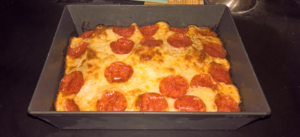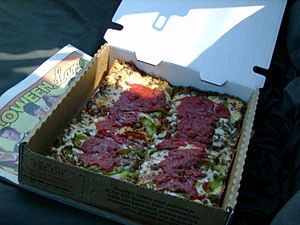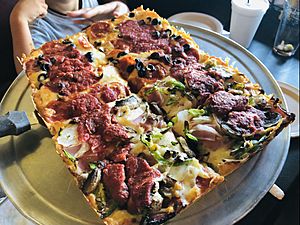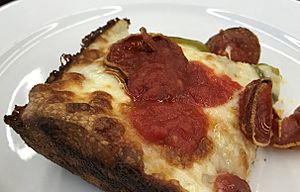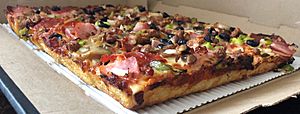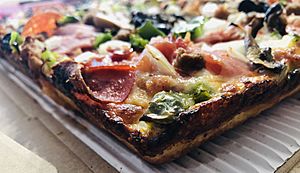Detroit-style pizza facts for kids

Detroit-style pizza
|
|
| Type | Pizza |
|---|---|
| Place of origin | United States |
| Region or state | Detroit, Michigan |
| Main ingredients | Pizza dough, tomato sauce, brick cheese |
Detroit-style pizza is a special kind of pizza that's shaped like a rectangle. It has a thick crust that's both crispy and chewy. This pizza usually has tomato sauce and Wisconsin brick cheese spread all the way to its edges.
What makes it unique is how it's baked. It's often cooked in rectangular steel pans. These pans were originally made for car factories to catch oil drips or hold small parts. This pizza style started in Detroit in the mid-1900s. Later, in the 2010s, it became popular across the United States. Detroit-style pizza is now one of Detroit's most famous local foods.
Contents
The Story of Detroit-Style Pizza
This unique pizza was first made in 1946 at a place called Buddy's Rendezvous in Detroit. Gus and Anna Guerra owned this restaurant. People aren't sure if the recipe came from Anna Guerra's mother or another employee. The recipe created a crust that was like focaccia, a type of Italian flatbread. Pepperoni was often pressed into the dough to add lots of flavor.
The restaurant used special blue steel pans to bake the pizzas. These pans came from local car factories. They were originally used as drip trays or to hold small parts. Regular baking pans weren't right for this new pizza. Some of these old pans, which are 50 to 75 years old, are still used today!
How Detroit-Style Pizza Grew
Buddy's Rendezvous later changed its name to Buddy's Pizza. In 1953, the Guerras sold Buddy's and opened another restaurant called the Cloverleaf. Other famous pizza places in the Detroit area, like Shield's and Loui's Pizza, were also started by people who had worked at Buddy's.
For a long time, this pizza was mostly known in the Detroit area. People didn't often call it "Detroit-style" until the 1980s. Even then, the name was mostly used in national magazines. Some people outside Detroit worried about using the name "Detroit-style" because they thought it might have a negative image.
Spreading Across the Country
In the 2010s, Detroit-style pizza started to become famous everywhere.
- In 2011, two brothers from Detroit opened a Detroit-style pizza restaurant in Austin, Texas. They used the name "Detroit-style" to show how special their pizza was.
- In 2012, a chef in New York made a pizza he called "Detroit-style," even though he had never been to Detroit.
A big moment happened in 2012. A local cook named Shawn Randazzo won a world championship at the Las Vegas International Pizza Expo with his Detroit-style pizza. After he won, many people in the pizza business wanted to learn how to make it. Randazzo even started a program to teach others how to make "authentic Detroit-style" pizza. By 2018, he had taught people from the U.S., Thailand, and South Korea. By 2019, you could find this pizza in places like Australia and Canada!
Why It Became So Popular
Around 2016, everyone seemed to be talking about Detroit-style pizza. A pizza magazine called Pizza Today said that "Perhaps no pizza style has entered the public consciousness in quite the way that Detroit-style pan pizza has." They said Randazzo's win "rocked the pizza world." Another magazine, Restaurant Hospitality, noted that the pizza became very popular on Instagram.
In 2019, Esquire magazine called it "one of the hottest food trends across America." Both the Detroit Free Press and Eater agreed that Detroit-style pizza was "having its moment."
Eater also pointed out that new pizzerias were making their own versions. Some stuck to the traditional style with cheese and sauce on top. Others made "artisanal" square pizzas with special doughs and organic toppings. These newer versions were often very photogenic, perfect for social media.
Between 2015 and 2019, Detroit-style pizza grew by about 66% on restaurant menus. Yelp.com reported in 2021 that reviews mentioning "Detroit-style pizza" were up by 52%. This shows how much it has grown!
Even big companies like Pizza Hut have tried to make their own Detroit-style pizzas. In 2021, Pizza Hut released four versions. Reviews were mixed, but many people liked the thick, crunchy crust and sweeter sauce.
What Makes Detroit-Style Pizza Special?
Detroit-style pizza is a deep-dish rectangular pizza. It's usually topped with Wisconsin brick cheese and a cooked tomato sauce.
The Crust and Cheese
The dough for this pizza is very wet, which helps create a chewy crust with a crispy outside. The fresh dough is left to rise twice and then stretched by hand to fit the pan. The crust should be about 1.5 inches thick. The crust gets its buttery flavor from a little oil and the way the mozzarella and Wisconsin brick cheeses melt.
The brick cheese is important because it can handle high heat. This cheese is spread all the way to the edges of the pan. As it bakes, the cheese caramelizes against the sides of the pan. This creates a crispy, lacy edge. This crispy, caramelized cheese edge is called frico. It's a key part of what makes this pizza so delicious!
How the Toppings Are Layered
Traditionally, the toppings are layered in a special way:
- The pepperoni is often placed directly on the crust.
- Then, almost a pound of brick cheese is added on top of the pepperoni.
- Other toppings might go on top of the cheese.
- The cooked sauce is the final layer. It's often added in dollops or in "racing stripes," which are two or three lines of sauce.
Sometimes, the sauce is even added after the pizza comes out of the oven. Because the sauce is often the very last topping, this style is sometimes called "red top" pizza.
Images for kids
See also
 In Spanish: Pizza estilo Detroit para niños
In Spanish: Pizza estilo Detroit para niños


